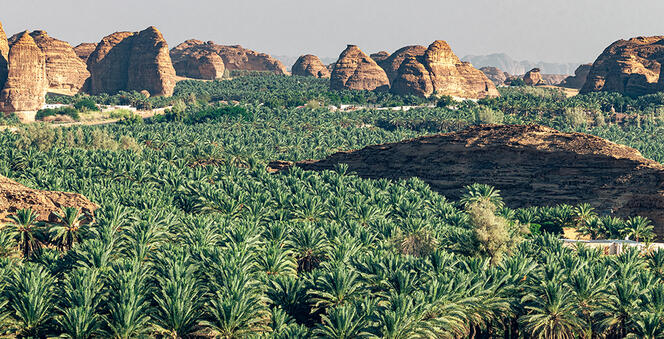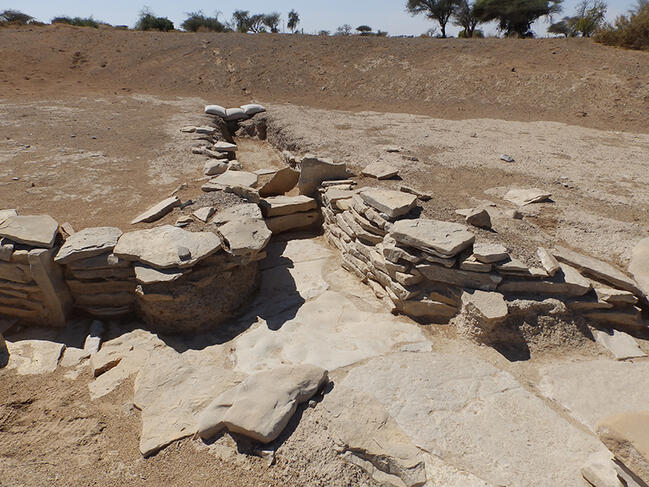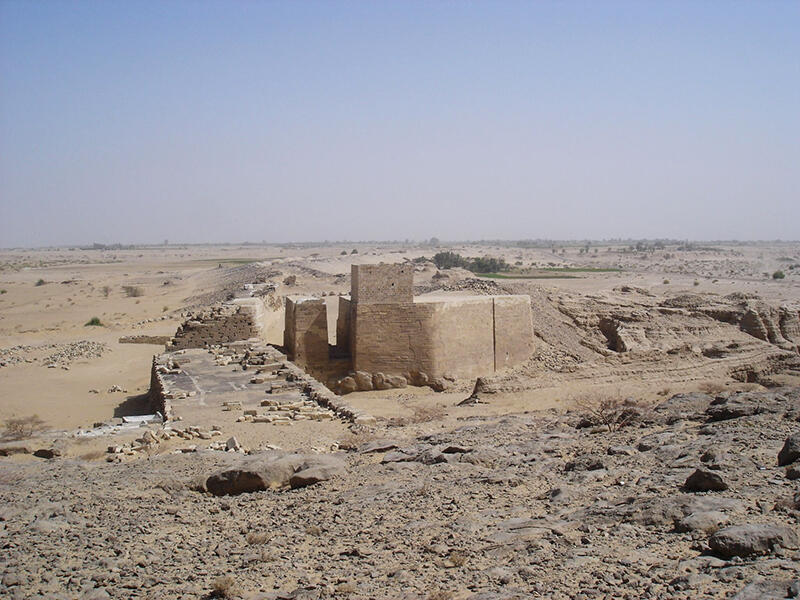You are here
9,000 years of hydraulics

Your work focuses on the history of cultivated landscapes and agriculture during the past five thousand years, and in particular on water and soil management in arid and semi-arid environments. When did early societies first start to manage water resources, and how did they go about it?
Louise Purdue1: Human societies have made use of water resources in various ways in response to geographical and time constraints. Archaeological, geographical and historical research has uncovered a wide range of systems designed to capture, store and transport water.
The first evidence of its capture dates back to the Neolithic, from 9,000 to 6,000 BC, in the Middle East. In areas with fluctuating water resources, especially on plateaus and in mountains, basic groundwater catchment systems were soon supplemented by the digging of wells when the aquifer was too deep, frequently on the scale of individual households. Some of these traditional methods are still in use today in the countries where I carry out part of my research, such as the United Arab Emirates, Oman and Saudi Arabia.
What about river valleys, where many human societies first emerged?
L. P.: In alluvial valleys with permanent water resources, such as along the banks of the Nile and the Euphrates, the harnessing of surface water and springs undoubtedly contributed to the emergence of human societies. Water was initially collected in rudimentary fashion, using buckets or goatskin bags, and then, from the third millennium BC, with the aid of a shaduf, a hand-operated device for lifting water from watercourses to irrigate small plots nearby. Then, with rapid population growth, these early societies gradually started to build larger, more complex hydraulic systems.
How do you explain this change in scale, from simple catchments deployed at the individual household level to much larger hydraulic structures?
L. P.: Population growth, leading to greater demand, was compounded by an increasingly dry climate in the Middle Holocene, beginning in the fourth millennium BC. This change in weather conditions, probably associated in arid environments with dwindling water resources, saw the development of new hydraulic techniques such as canals, reservoirs, cisterns and dams, for farming, household use and metalworking.
Later on, around the first millennium BC (the Iron Age), these systems were perfected and extended. They included qanats (called ‘foggaras’ in the Northern Sahara), underground aqueducts that collected groundwater and transported it by gravity to a location where it could be used for household or agricultural purposes. Originating in Iran and southeastern Arabia, qanats spread throughout the world as a result of territorial conquests and trade, via the Romans in North Africa and the Western Mediterranean, European colonists in South America, and even as far as China along the Silk Road.
In competition with this larger, more stable supply of water, other techniques such as run-off water channels were apparently abandoned in some regions like southeastern Arabia. This shift in technology went hand-in-hand with agricultural specialisation, leading to the replacement of subsistence crops by highly water-intensive cash crops such as date palms. Building and maintaining these networks, which sometimes extended over tens of kilometres, required a great deal of manpower and cooperation.
Was a new kind of social organisation therefore needed in order to manage water resources?
L. P.: To build such large-scale hydraulic systems, it was necessary to assess the availability of water, collect and transport it, estimate the needs of agriculture and local populations, and manage infrastructure maintenance, while at the same time taking into account technical capabilities and demographic trends. Water was no longer just a resource, but a common good that required real hydraulic expertise.

It is widely accepted that the development of large-scale hydraulic engineering in the Middle East (Assyria, Mesopotamia, Egypt), in Asia (Indus, China), and in Central and South America (Mayas, Incas) was closely dependent on the socio-economic and political stability of these societies. And in turn, advances in this field fostered urban expansion, the establishment of trade and exchange networks, and political balance.
This was true of oases, for example, which were artificial environments entirely created by humans around water and soil resources. They first appeared, particularly in Arabia, around the third millennium BC, becoming real hubs of communication in the middle of the desert. However, the smaller systems, probably managed at the household or community level, that co-existed with these larger facilities should not be overlooked.
What remains today of the large-scale hydraulic systems developed over the past few thousand years?
L. P.: Technical and economic specialisation in early societies, frequently coupled with population pressure, indirectly increased their vulnerability to environmental change. Unpredictable factors, such as episodes of repeated droughts or flooding, had an impact on available resources. In extreme cases, such events drove populations to migrate, whenever this was possible. The ensuing decrease in the workforce inexorably led to the decline of hydraulic systems. As a result, the landscape became dotted with the remains of hydraulic structures abandoned over the centuries. For example, ruins are all that is left of the 15-metre-high, 600-metre-long Great Dam of Ma'rib, in Yemen, which was destroyed by repeated torrential flooding in the sixth century BC.

However, not all these techniques have been totally lost. For instance, some qanats are still in use today, particularly in Iran and China. Nonetheless, diminishing water resources are jeopardising these infrastructures. Aside from the current impacts of climate change, the development of electric pumps to extract groundwater for agricultural uses has greatly contributed to falling water tables over the past 70-80 years.
In arid environments, this technological innovation initially led to an expansion in farmland, although its implementation has proved detrimental to the effective management and preservation of water resources. In these areas, aquifers have fallen to very deep levels, making it impossible to return to qanat-type groundwater collection techniques.
Are there any other ancient, more rational methods for harnessing water resources that we could draw on today?
L. P.: At the moment, one of the priorities is to preserve water resources. To do this, various techniques, either discovered during archaeological excavations or mentioned in written sources, could be reintroduced. These mainly concern the collection of surface water, and include the construction of agricultural terraces that directly capture rainwater, the implementation of systems for collecting run-off water from slopes in cisterns or directly in agricultural plots, direct diversion of floodwater from watercourses, and reduction of ploughing to limit run-off (and therefore water loss) as well as soil erosion.
As far back as the 1980s, it was estimated that rainwater harvesting could increase the area of farmland by 3 to 5% in desert environments2. As well as saving water, it is now widely admitted that these techniques are the best ways to boost soil productivity, preserve water resources in semi-arid and arid environments, and implement climate-resilient irrigation.
For example, they contributed to the greening of the Negev desert from the Nabataean to Byzantine periods. After being abandoned for nearly 1,000 years, the reclamation and reuse of some of these systems over the past fifty years, particularly in Wadi Mashash as part of a research project at Ben-Gurion University of the Negev (Israel), has led to the development of sustainable agro-ecosystems for the production of food, fodder and wood.
An example that should be reproduced then?
L. P.: To date, there aren't many example of this kind of reclamation. This is because, despite the effectiveness of such methods and the prior research work undertaken to understand how they work, as well as the efforts of associations and research teams to preserve and rehabilitate them, this approach above all requires local investment. I see this in the joint French-Saudi project on the history of the Al Ula oasis (Saudi Arabia) in which I am involved. Whenever necessary, we need to pass on our knowledge to local populations, and raise their awareness of ecological issues, the need to preserve traditional methods, the notions of risk and uncertainty, and the importance of protecting water supply networks and systems. Learning to take a long-term view is a long-term challenge! ♦
- 1. Louise Purdue is a CNRS researcher at the CEPAM laboratory (CNRS / Université Côte d 'Azur). She was awarded the CNRS Bronze Medal in 2020 and the CNRS Science Outreach Prize in 2022.
- 2. https://www.sciencedirect.com/science/article/abs/pii/0143622886900263?v(link is external)...






















